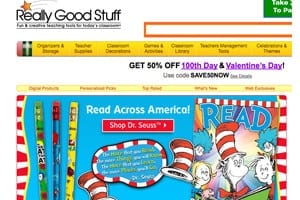
In the Most Wanted series, Chief Marketer looks at some of the top demographic segments marketers need to target in 2017. This week, we look at K-12 teachers.
Who: This one’s pretty self-explanatory: K-12 teachers teach students in kindergarten and in grades from 1 to 12, in public, private and for-profit schools.
The Stats: In 2015, the number of K–12 teachers in the U.S. exceeded 3.9 million, according to Shelton, CT-based Market Data Retrieval (MDR), which specializes in the education market. And according to Denver-based Agile Education Marketing, during the 2015–16 school year, those teachers spent an average of $487 out-of-pocket on work-related items, with 87% going toward classroom supplies. That adds up to roughly $1.9 billion in spending power, with $1.65 billion of that being spent on supplies ranging from crayons to stickers to pencil sharpeners. And it doesn’t take into account “discretionary funding” that many teachers receive from their schools or districts to buy materials.
Why You Want to Reach Them: Beside their appreciable buying power, “teachers are often critical components of the sales cycle, serving as key influencers in the decision-making process” in schools and school districts, says Brandee Johnson, president of Pittsburg, KS-based LimeLight Marketing. Given that spending on K–12 instructional materials hit $11.5 billion in 2015, according to MDR’s “State of the K–12 Market 2015” report, that’s just as compelling a reason as the spending power instructors directly wield. Generally speaking, Johnson adds, “as the price point of a product or solution increases, teachers have less decision-making authority and become influencers in the process.” So while teachers may be buying holiday decorations and posters of the periodic table themselves, they often have considerable input on the type of tablets and software their schools invest in.
Preferred Channels: Of the teachers who participated in Agile Education Marketing and SheerID’s 2016 Understanding Teacher Spending and Loyalty survey, a full 66% said they trusted email newsletters and offers for product information, behind only word of mouth (73%) as an information source. Slightly more than half (53%) cited conferences, with social media (38%) and catalogs (36%) rounding out the top five sources. “More and more companies are finding success in reaching teachers through digital marketing using channels like social media, email marketing, SEO and pay-per-click advertising,” Johnson confirms.
The most effective marketing relies on content—lesson-planning tips, craft suggestions, career-path advice—to engage with this audience. This is where digital has a distinct edge. E-newsletters that include articles alongside (or even instead of) product offers, blogs that live on ecommerce sites, online forums where teachers can connect with one another, Pinterest boards that show innovative ways to set up classrooms—all give teachers a reason to engage with your brand even when they’re not actively seeking to buy—which makes them much more likely to return to you when they are ready to make a purchase.
“Follow the rule of ‘give, give, give, ask,’” Johnson advises. “Whether you’re posting to social media or sending emails, give content of value more often than making an aggressive sales ask.”
Another advantage of digital marketing is that instructors tend to buy more online than offline. In the Agile/SheerID report previously mentioned, 39% of those surveyed said they purchase more online, compared with 18% who said they buy more in stores; 43% said their expenditures were evenly split between online and stores.
Who’s Getting It Right: Monroe, CT-based Really Good Stuff uses its social channels less to tout its teaching and classroom supplies than to offer advice and encouragement to teachers. On Twitter, for instance, it hosts a monthly #TeachChat; its Pinterest boards include craft ideas, grade-appropriate activities and articles on classroom management; on Instagram and Facebook it initiates conversations on topics ranging from favorite read-aloud books to in-class learning routines. The company also uses social media to direct teachers to its robust blog and its teachers’ forum.
And bearing in mind how highly teachers rate email, Really Good Stuff offers the choice of subscribing to promotional emails and/or a “weekly email recap” that includes content as well as savings and special offers. Its website even includes free downloadable e-books and printable student activity sheets—providing plenty of “give, give.”
Though it sells women’s clothing, New York-based retailer Loft makes an effort to win over teachers by offering them a 15% discount on in-store purchases and other special perks by subscribing to its emails. Discounts can go a long way to engendering loyalty among teachers: 84% of those surveyed by Agile said they were more loyal to brands that offered teacher discounts, though 74% did say the discount must be at least 20% to “pique their interest.” Loft promotes the offer with a “Loft Loves Teachers” link on its site, and in the past, it had run “best-dressed teacher” promotions and a tie-in with the now-shuttered Lucky magazine, among other campaigns.
Related Articles:
Marketing Automation Helps Lego Education Connect With Teachers

 Network
Network

